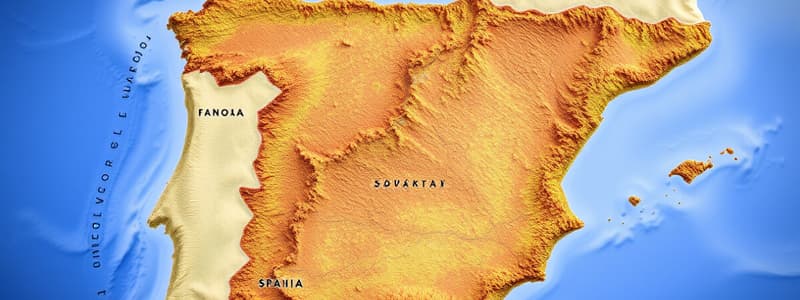Podcast
Questions and Answers
Columbus named the island he discovered as ______
Columbus named the island he discovered as ______
San Salvador
After landing, Columbus referred to the native peoples as ______
After landing, Columbus referred to the native peoples as ______
Indians
Columbus's second voyage consisted of ______ ships
Columbus's second voyage consisted of ______ ships
17
The territory of Spain today comprises ____ square miles.
The territory of Spain today comprises ____ square miles.
Columbus made first contact with the mainland of ______ during his third voyage
Columbus made first contact with the mainland of ______ during his third voyage
Columbus sailed along the coastline of ______ during his fourth voyage
Columbus sailed along the coastline of ______ during his fourth voyage
Spain shares borders with Portugal to the West and ____ to the North.
Spain shares borders with Portugal to the West and ____ to the North.
Spain controls the Balearic Islands in the Mediterranean and the ____ Islands in the Atlantic.
Spain controls the Balearic Islands in the Mediterranean and the ____ Islands in the Atlantic.
At the beginning of the 19th century, Spain laid claim to over ____ million square miles of territory.
At the beginning of the 19th century, Spain laid claim to over ____ million square miles of territory.
Queen Isabella of Castile and King Ferdinand of Aragon unified their kingdoms in ____.
Queen Isabella of Castile and King Ferdinand of Aragon unified their kingdoms in ____.
The last remaining Muslim faction in Spain was the Emirate of ____.
The last remaining Muslim faction in Spain was the Emirate of ____.
____ sought a faster sea route to the spice-producing East Indies in the 1420s.
____ sought a faster sea route to the spice-producing East Indies in the 1420s.
Christopher Columbus was a Genoese sailor who proposed to reach Asia by sailing ____ into the Atlantic.
Christopher Columbus was a Genoese sailor who proposed to reach Asia by sailing ____ into the Atlantic.
Columbus set sail on August 3, ____ with three ships.
Columbus set sail on August 3, ____ with three ships.
Columbus's three ships were called the Nina, the Pinta, and the ____.
Columbus's three ships were called the Nina, the Pinta, and the ____.
Flashcards are hidden until you start studying
Study Notes
Geography and Territory of Spain
- Spain's current area is approximately 195,365 square miles, mainly located on the Iberian Peninsula.
- Borders Portugal to the west, France to the north, and Andorra, a small principality.
- Spanish territories include the Balearic Islands in the Mediterranean, the Canary Islands in the Atlantic, and two enclaves, Ceuta and Melilla, on Morocco’s northern coastline.
- In the 19th century, Spain laid claim to over 5 million square miles, spanning nearly the entire Americas and the Philippines.
Formation of Spain
- In the late 15th century, the Iberian Peninsula consisted of several Christian kingdoms, primarily Castile and Aragon.
- These kingdoms gradually reclaimed territory lost to Muslim invaders, the Moors, who occupied much of Iberia since the early 8th century.
- The marriage of Queen Isabella I of Castile and King Ferdinand II of Aragon in 1469 united their kingdoms, marking a significant political consolidation.
The Reconquista and Expansion
- The Catholic Monarchs completed the Reconquista by conquering the Emirate of Granada in 1491, marking the end of Muslim rule in Iberia.
- After securing their internal borders, Isabella and Ferdinand aimed to expand Spain's influence through overseas exploration and trade.
Age of Exploration
- Inspired by Portugal's earlier explorations for trade routes to the East Indies, Columbus pitched a new westward route to King John II of Portugal, but was unsuccessful.
- Isabella and Ferdinand, seeking to rival Portugal, funded Columbus's expedition.
Columbus's Voyages
- Columbus set sail on August 3, 1492, with three ships: the Niña, the Pinta, and the Santa Maria.
- He reached land on October 12, 1492, on an island he named San Salvador, mistakenly believing it was part of the East Indies, referring to the natives as Indians.
- His exploration extended to the Bahamas, northern Cuba, and Hispaniola before returning to Spain in January 1493, claiming new lands for Europe.
- A second voyage involving 17 ships further charted the Caribbean, while a third voyage discovered the South American mainland.
- Columbus's final voyage (1502 onwards) explored parts of Central America before his death in 1506, realizing he had found a new continent.
Studying That Suits You
Use AI to generate personalized quizzes and flashcards to suit your learning preferences.




